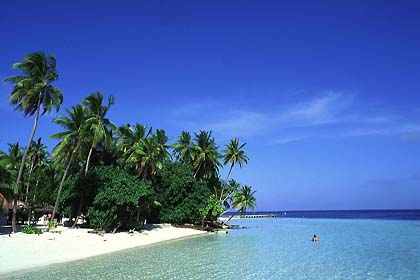The Maldives - A Nation of Islands

The Maldives are scattered across the Indian Ocean, like gems skipping across the equator. This nation of islands depict a rare
perfect vision of a tropical paradise ala Robinson Crusoe. Palm fringed islands with sparkling deserted white beaches, turquoise
lagoons, clear warm waters and coral reefs teeming with abundant varieties of marine flora and fauna, fascinate visitors as it has
for thousands of years. Marco Polo referred to the Maldives as the ‘...flower of the Indies’, and Ibn Batuta called her in his
chronicles ‘One of the wonders of the World’.

Truly a natural wonder, the Republic of Maldives is a sinking nation. The highest point on the islands is just a few feet above sea
level. With the very real and imminent threat of global warming, rising oceans will some day submerge the doomed atolls of the
Maldives--another great reason to travel now! The local Maldivians are seemingly nonchalant about their fate. More and more
5 star resorts are popping up on outer atolls with measures being taken for environmental concerns. However, most resorts are
air-conditioned and require a massive support system to cater to upscale clientele.

The 1,087 islands consist of 19 atoll formations and are spread over an area of 56,000 square miles. The islands are broken up
into 4 regions--North and South Male Atolls, Ari Atoll and Felidhu Atoll. The islands are surrounded by shallow crystal clear
lagoons enclosed by coral reefs. These unique islands provide visitors with one of the most breathtaking views of underwater
life in the world. Formed above peaks emerging from the depths of the ocean, upon layers of both living and dead coral as well
as remnants of other marine life, the island interiors are generally covered with dense tropical vegetation. Coconut palms tower
above dense undergrowth protecting the shores from erosion. The smaller islands are sand banks under formation.

Measuring 510 miles north to south and 75 miles east to west at its greatest width, the closest neighbors are India and Sri
Lanka. With a population of 238,500 only 199 islands are inhabited with another 74 set aside exclusively for tourist resort
development. The origins of the Maldivians are lost in ancient history. As a crossroads on an important trade route, the
Maldives were settled by people from all over the world. This leaves the origins of the people enshrined in mystery. Throughout
the Maldives a language which belongs to the Indo-Iranian group, Dhivehi, is spoken. It shows a strong Arabic Dhivehi written
from right to left is the official language of the country. As a second working language English is widely used in Government
offices and commerce. Male is the capital and the seat of Government.
The climate is warm year round, determined by the monsoons. However, being on the equator, the monsoons are mild and not
as defined as in neighboring countries. Of the two monsoons, the southwest monsoon from May to October, brings more rain
and wind. The northeast monsoon, from November to April, is the dry season with very little wind. The air temperature ranges
from a maximum of 94°F to a minimum of 75°F while the water temperature from 82°F to 86°F. The annual rainfall is around
12 inches with a total of over 2,700 hours of sunshine each year. Singapore Airlines offers non-stop service several times a
week from Singapore to make it convenient to get there.
Return to Main Page




